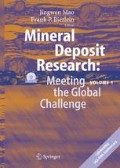Abstract
High salinity fluid inclusions (Th=200–550°C) from the Broken Hill and Cannington “Broken Hill-type” ore deposits in Australia have been analysed by PIXE and LA-ICP-MS. They have high Pb (>1%) and Zn (>1000 ppm) and Pb/Zn ratios much higher than those of the majority of crustal brines. Laser Raman studies reveal the presence of methane and PIXE images show that Pb and Zn are respectively concentrated in a Pb-K-Cl solid, and the liquid phase. This indicates that the inclusions have very low total sulphur contents. The Pb/Zn ratios are similar to those of eutectic melts in the Gn-Sp-Po system whereas Pb/Fe ratios are variable and lower than those of such melts. If these brines originated by fractionation from synmetamorphic sulphide-rich melts, then they must been greatly modified prior to entrapment. An alternative origin involving late-to post-metamorphic interaction of externally-derived brines with pre-existing sulphide accumulations should also be considered. In either case, the unique brine chemistry would appear to relate to the large amounts of sulphides in these systems.
Access this chapter
Tax calculation will be finalised at checkout
Purchases are for personal use only
Preview
Unable to display preview. Download preview PDF.
References
Chapman LH, Williams PJ (1998) Evolution of pyroxene-pyroxenoid-garnet alteration at the Cannington Ag-Pb-Zn deposit Cloncurry district, Queensland, Australia: Econ Geol 93: 1390–1405
Giles D, Nutman AP (2002) SHRIMP U_Pb monazite dating of 1600–1580 Ma amphibolite facies metamorphism in the southeastern Mt Isa Block, Australia. Austr J Earth Sci 49: 455–465
Heinrich CA, Pettke T, Halter WE, Aigner-Torres M, Audétat A, Günther D, Hattendorf B, Bleiner D, Guillong M, Horn I (2003) Quantitative multi-element analysis of minerals, fluid and melt inclusions by laser-ablation inductively-coupled plasma mass-spectrometry: Geochim Cosmochim Acta 67: 3473–3496
Hemley JJ, Cygan GL, Fein JB, Robinson GR, D’Angelo WM (1992) Hydrothermal ore-forming processes in the light of studies in rock-buffered systems: I, iron-copper-zinc-lead sulfide solubility relations: Econ Geol 87: 1–22
Kendrick MA, Burgess R, Pattrick RAD, Turner G (2001) Fluid inclusion noble gas and halogen evidence on the origin of Cu-porphyry mineralising fluids. Geochim Cosmochim Acta 65: 2651–2668
Mavrogenes JA, Macintosh JW, Ellis DJ (2001) Partial melting of the Broken Hill galena-sphalerite ore. Experimental studies in the system PbS-FeS-ZnS-(Ag2S). Econ Geol 96: 205–210
Mungall JE, Brenan JM, (2003) Experimental evidence for the chalcophile behavior of halogens. Can Mineral 41: 207–220
Pollard PJ, Perkins C (1997) 40Ar/39Ar geochronology of alteration and Cu-Au-Co mineralization in the Cloncurry district, Mount Isa Inlier. AMIRA P438 Cloncurry Base Metals and Gold Final Report, Section 3, 40pp
Ryan CG, McInnes, BM, Williams PJ, Guoyi Dong, Tin Tin Win, Yeats CJ (2001) Imaging fluid inclusion content using the new CSIRO-GEMOC nuclear microprobe. Instr Meth Physics Res B 181: 570–577
Spry PG (1978) The geochemistry of garnet-rich lithologies associated with the Broken Hill orebody, N.S.W., Australia. Unpubl MSc thesis, University of Adelaide, 129pp
Svenson H, Jamtveit B, Yardley B, Engvik AK, Austrheim H, Broman C (1999) Lead and bromine enrichment in eclogite-facies fluids: extreme fractionation during lower-crustal hydration. Geology 27: 467–470
Walters SG (1998) Broken Hill-type deposits. AGSO J Austr Geol Geophys 17: 229–237
Wilkins RWT (1977) Fluid inclusion assemblages of the stratiform Broken Hill ore deposit, New South Wales, Australia. Science 198: 185–187
Williams PJ, Dong Guoyi, Prendergast K, Pollard PJ, Ryan CG (1999) Metasomatism and metal mobility in Broken Hill-type deposits. In: Stanley CJ et al. (eds) Mineral Deposits: Processes to Processing. Balkema, Rotterdam, pp 999–1002
Yardley B, Bennett A, Banks D (2003) Controls on the chemical composition of crustal brines. J Geochem Expl 78/79: 133–135
Author information
Authors and Affiliations
Editor information
Editors and Affiliations
Rights and permissions
Copyright information
© 2005 Springer-Verlag Berlin Heidelberg
About this paper
Cite this paper
Williams, P.J., Guoyi, D., Yardley, B., Ullrich, T., Ryan, C., Mernagh, T. (2005). Lead and zinc-rich fluid inclusions in Broken Hill-type deposits: Fractionates from sulphide-rich melts or consequences of exotic fluid infiltration?. In: Mao, J., Bierlein, F.P. (eds) Mineral Deposit Research: Meeting the Global Challenge. Springer, Berlin, Heidelberg. https://doi.org/10.1007/3-540-27946-6_219
Download citation
DOI: https://doi.org/10.1007/3-540-27946-6_219
Publisher Name: Springer, Berlin, Heidelberg
Print ISBN: 978-3-540-27945-7
Online ISBN: 978-3-540-27946-4
eBook Packages: Earth and Environmental ScienceEarth and Environmental Science (R0)

